There are a lot of sources that say walking is the number one form of exercise around the world. In fact, with the modern-day fitness tracker, it’s rare to find someone who isn’t counting their steps from leisurely strollers to power walkers!
And it makes sense: walking is one of the most simple, effective and convenient ways to get exercise. It’s readily available, requires no special equipment, and is great for people of all ages. When you first start out however or return after a long time off, you may be surprised to find that you’re pretty sore the next day!
That’s why it’s important to start with moderation and include a good stretching routine.
Stretches for walkers are important for preventing both soreness and injury. When muscles are tight in one area of your body, it can create tension in other areas as you may start to overcompensate for the tight spot.
Tight muscles not only keep you from potentially walking again the next day, but they may also pull you out of proper alignment leading to muscular imbalance and injury.
This routine will provide you with moves to help keep you walking freely with stretches for hip pain, tight calves, and all the other places that get out of whack from your walk!
Benefits of Walking
Aside from potential tightness, let’s remember that walking is an excellent form of exercise! According to the American Heart Association, a regular walking routine can help you:
- Reduce your risk of coronary heart disease and stroke
- Improve your blood pressure, blood sugar levels an blood lipid profile
- Maintain your body weight and lower the risk of obesity
- Enhance your mental well-being
- Reduce your risk of osteoporosis
- Reduce your risk of breast and colon cancer
- Reduce your risk of type 2 diabetes
That doesn’t even count the benefits of things like getting fresh air, raising your level of endorphins (happiness hormone), and lowering the risk of depression! Walking is just plain awesome!
Related: How Many Steps Do You Really Need a Day?
What To Expect With Your New Walking Routine
Maybe it sounds silly to say you need tips on walking. After all, you’ve been doing it all your life. However, walking for your health should be done a little differently and there a few important things to remember:
Equipment: While walking doesn’t really require any special equipment, the proper footwear and clothing can make the experience much more pleasurable and help you stick with it. A good pair of walking shoes is recommended, but any good athletic shoes that fit will be fine. Make sure they are supportive and have enough cushion. Your old lawn mowing shoes from 10 years ago might not do the trick! In addition, get socks made with a synthetic fiber such as acrylic, polypropylene or Coolmax. Cotton socks can often lead to blisters! Comfortable clothes made with those same types of fabric are also a smart idea.
Form: Walking for fitness means you are going to walk a bit faster than just taking an afternoon stroll. This means you’ll want to use proper form. First, be sure to keep your shoulders back and down to avoid the “hunchback” that can happen with poor posture. Second, draw your abdominals in and keep them pulled in while you walk to prevent lower back pain. Third, swing your arms close by your side and use them to help you propel yourself a bit faster. Keep your hands relaxed. Finally, use a heel-to-toe motion with your feet.
Build Gradually: Don’t go out for a 5-mile walk on your first day! This will wreak havoc on your knees, hips and probably leave you with calves that ache all night. Like with any kind of fitness, you need to build your time gradually. If you haven’t done anything in a long time, start by committing to 10 or 15 minutes. Make sure to start slowly to warm your body up and build speed as you go. Slow down again toward the end and, of course, be sure to stretch! But we’ll get to that in a moment. Once you feel energized by your 15 minutes – perhaps after a week or so – add another 5 minutes. Do that a few times and then add another 5 until you get to your desired walking time. Most people aim for an average of 30-40 minutes 3-4 times a week. Keep in mind everyone is different and we all have different goals. Do what works for you.
Stretch: One of the great things about walking is that is it low impact. This means it will be more gentle on your joints, muscles and connective tissue than high impact workouts like running. However, injuries can happen with any activity so stretching remains an important part of your walking plan. Some of the most common walking injuries include:
- Low Back Injury
- Hip Injury
- Shin Splints
- Plantar Fasciitis (foot and heel injury)
- Achilles Tendonitis
The below stretches will help you prevent these common injuries and keep you walking for a long, long time! These basic stretches should be done both prior to your walk and immediately following.
BEFORE THE WALK STRETCHES
WHY: Spinal mobility is the key to everything you do physically. Cat/Cow is something you can and should do for your spine health every day. It is gentle yet effective at stretching your spine and neck.
HOW: Begin on your hands and knees with hands below shoulders and knees below hips. As you exhale, lift your belly button up while your arch your back like a cat letting your head and tailbone drop toward the floor. As you inhale, lift your chest and tailbone while letting your belly and back lower toward the floor. Be sure you don’t collapse your spine downward but focus on the lift of the chest and tail. Try 5 sets of Cat/Cow.
Chest Expansion
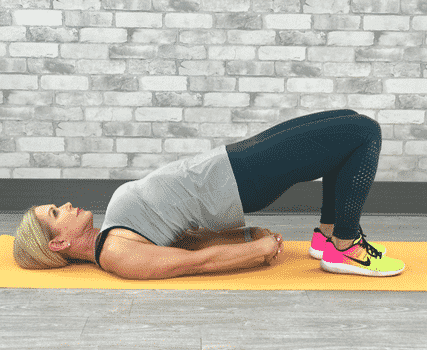
WHY: Good posture starts with a strong core and open, stretched muscles in the front of your body. If your chest and shoulders are tight or weak, you will hunch forward and create bad posture for walking leading to back pain.
HOW: Reach both hands behind your back and interlace your fingers. If they don’t touch, hold a small towel or shirt on each side to bridge the gap between your hands. Stand and hold for 30 seconds. If you are able, fold your body forward and let the clasped hands fall over the back of your head. Hold and breathe for 30 seconds.
Lateral Stretches
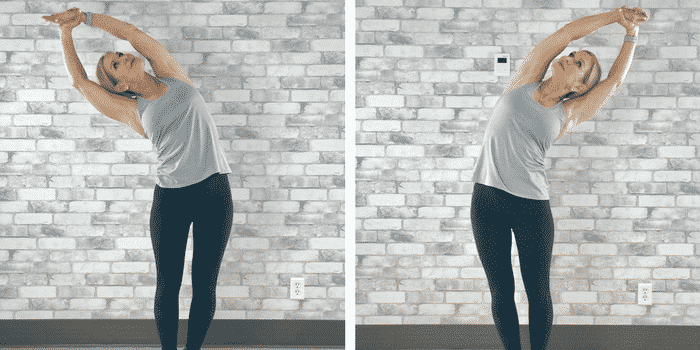
WHY: A compressed and tight mid-section is no way to start off a walk! It will set you up for all kinds of issues such as poor form, bad posture and a tight lower back while you’re walking. The lateral stretch lengthens your ab muscles, spine, hips and thighs. This stretch improves the flexibility in your spine and lengthens both the upper and lower body.
HOW: Stand tall with legs pressed together and arms reaching overhead. Grab your right wrist and pull your right arm straight over your ear bending to the left. Gaze up and slightly roll your right shoulder back. Squeeze your glutes, quads and abdominals tightly while you hold for 15 seconds. Switch sides. Repeat 2-3 times per side.
Calf Stretch
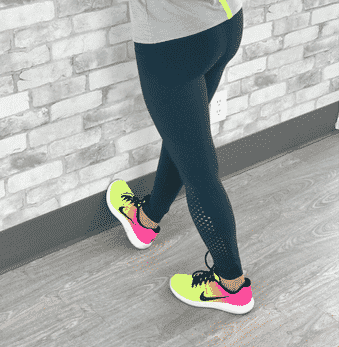
WHY: Each different type of exercise presents its own unique type of muscle tightness. Runners have tight quads and hamstrings while walkers tend to have tight calves due to the motion of the foot. Tight calves are not only a problem for the calf, but also for the feet. When the muscles in your calf are tight they pull on the heel bone, which creates a tighter plantar fascia and sets you up for a nasty bout of plantar fasciitis. It’s important to stretch your calves both before AND after your walk!
HOW: Stand on the edge of a box or curb. Extend one heel off the step and slightly bend that knee. Allow the heel to drop below the step. Hold for 30 seconds, then switch to the other calf. Repeat 3 times.
AFTER THE WALK STRETCHES
Calf/Foot/Shin Stretch

WHY: As stated before, the calf and foot are an integral part of walking and usually the first to feel the effects. In addition, shin splints can crop of before you blink. This stretch takes care of it all!
HOW: Stand at a door jam or in front of a solid sign post. Make sure your heel is on a solid surface (not soft grass or mud). Place your heel on the ground right next to the jamb or post and the bottom or sole of your foot against the post. Holding the sign or door frame with your hands, straighten your leg and lean forward pressing the foot in as deep as you can. You should feel the stretch on the bottom of your foot, in your heel and achilles, calf and possibly shins. Hold the stretch 30 seconds each foot.
Seated Spinal Twist
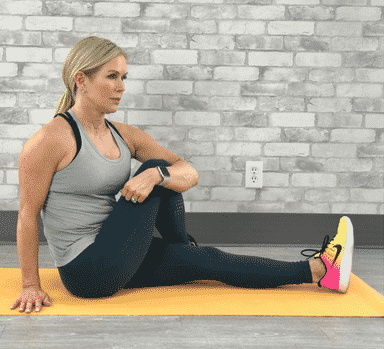
WHY: Depending on your gait and stride, walking can wreak havoc on your piriformis, the muscle that sits deep into the hips just behind your hip bones. Thus, it’s an important one to stretch. Seated spinal twists allow you to go as deep as you want. If you are extremely tight, you’ll pull the leg and twist gently and minimally. If you need a deeper stretch, you’ll give it a nice big squeeze.
HOW: Sit on the floor with legs extended out in front of you. Cross your right foot over your left leg as near to the hip as you can. Wrap your left arm around your right knee and pull it toward your body. Slightly twist to the right. Hold for 30 seconds and switch sides.
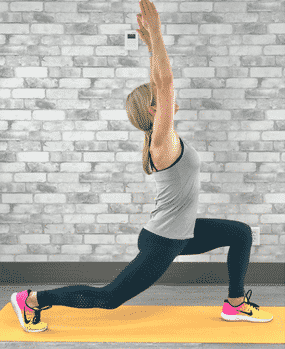
WHY: Hip flexors are another very common area to become tight and prone to injury with a lot of walking. About 80% of the force that is generated from walking comes from the hip flexors, so these muscle groups really get a workout during a long walk. The yoga pose crescent lunge is an excellent, if not one of the best, ways to open up your hip flexors and stretch the front of the hips.
HOW: From a standing position, step the ball of your left foot back. Bend your front knee 90 degrees and reach both arms overhead. Relax your shoulders and continue to tuck your tailbone under your body and lengthen your back leg for a deeper stretch. You can place your back knee on the ground to modify if needed.

WHY: Earlier we talked about keeping the chest muscles open for good posture. This will reinforce that notion as well as open the front of the hips and hip flexors while strengthening your backside muscles.
HOW: Lay on your back with knees bent and feet flat on the floor close to glutes. Tuck your shoulders under you, tighten your abs and lift your hips up as high as you can. Align knees with hip bones. Interlace hands under the body and press them into the floor. Squeeze your glutes and abs but keep your neck relaxed.
Other great walking workouts that are free to you include:
3 Walking Workouts To Boost Your Weight Loss – a great walking plan put together just for you.
Walk and Tone Walking Videos – free online videos for you to walk along with at home!
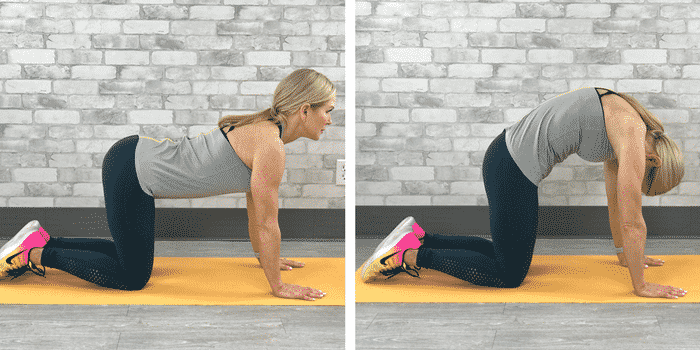
4 Comments
mary91 on October 27, 2021 at 1:55 PM
It was interesting to read the article! Thanks! I can't get into the habit of exercising, but walking is something I can do. I try to walk at least 5,000 steps every day, and that's already progress for me. And also what I like about sports is stretching. I'm ready to do stretching on a daily basis.
Sandy on February 22, 2021 at 4:49 AM
I’m not certain the photos and/or instructions are correct for each of these. Please revise if necessary.
Chris Freytag on March 17, 2021 at 1:46 PM
Hi Sandy - Just took a look at this blog. These photos are all of myself, me Chris Freytag, and the descriptions of each pose is also correct. I am happy to take a further look into this but would love some more guidance on what you are referring to that is incorrect? Thanks for your help!
Alex Stewart on October 9, 2019 at 10:14 PM
Stretching in water is also very good for you ie in a swimming pool it takes the weight off the joints .I find your blog's very helpful and interesting alex.